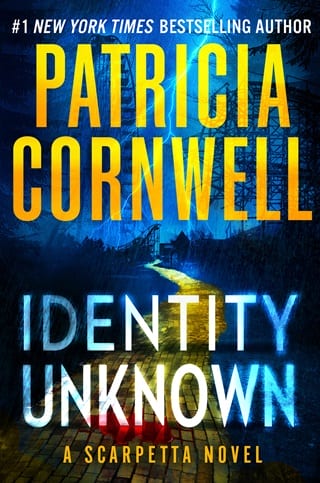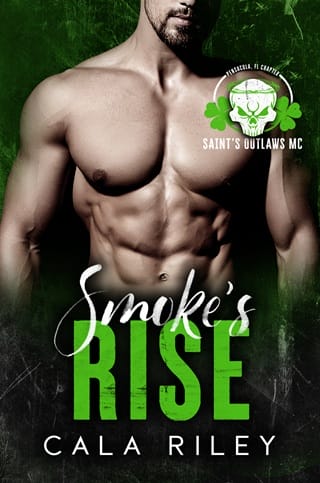Chapter 20
CHAPTER 20
P ainting the UV light over the hands and arms, I’m surprised that the pi sign tattoo glows a brilliant yellow.
“The ink has some sort of fluorescent additive,” I explain as it occurs to me why Sal might have had the tattoo to begin with.
Maybe the reason wasn’t merely decorative or symbolic. Perhaps holding the tattoo over certain scanners granted access into off-limits places such as Area One storage containers and mortuary drawers. Possibly the tattoo was a form of secret identification, a skeleton key to forbidden knowledge. I propose this to our audience as I continue collecting evidence in the dark, and no one denies or confirms.
“Is there a need for retaining the tattoo?” What I’m asking is if I should excise it, preserving it in formalin. “Possibly there’s a computer chip under the skin or something that should be recovered?”
“That won’t be necessary,” Gus says, and if he knows the purpose of the tattoo, he isn’t saying.
I continue searching and collecting, then flip the lights back on, everybody squinting. Picking up a clipboard from the countertop, I begin charting multiple injuries on body diagrams. I fill more test tubes with blood, and take vitreous fluid from the eyes, now a cloudy grayish blue. I dictate, and Marino writes it down.
Opening what the cops call a rape kit, I swab every orifice as I would a victim of sexual assault. Since I can’t know what Sal was subjected to, I intend to leave nothing to the imagination. If something isn’t done properly, there’s no going back. The time on the old wall clock ticks close to 9:30 P.M. as I turn on the faucet in the sink at the foot of the table.
I run my scalpel from clavicle to clavicle, down the torso, detouring around the navel, ending at the pelvis. Reflecting back tissue, I slice through the breastplate of ribs, removing it. Placing the bloc of organs on the cutting board, I cut through connective tissue, rinsing with water I squeeze from a big sponge.
I begin dictating pathological details, the heart within normal limits, the blood vessels patent and clear of plaque. The lungs were punctured by broken ribs, and the spleen is ruptured. I weigh the left kidney, then the right, each 161 grams, I tell Marino. The liver is contused, and I lift it out of the hanging scale, setting it on the plastic cutting board.
I begin slicing with a long-bladed knife, saving sections in a jar of formalin, dropping the rest in the plastic bucket under the table. Retrieving a steel cup from the surgical cart, I measure the amount of hemorrhaged blood pooled inside the empty chest cavity.
“About five hundred milliliters,” I explain. “Or around seventeen ounces. Most likely he was unconscious after hitting the ground and soon after went into shock.”
“Are you finding anything that might make you think he was tortured?” the secretary of state asks. “Why is his skin red? I’m wondering if they burned him.” He’s leaning forward in his chair, looking down impassively at the carnage on my table.
“Who’s they ?” Marino wants to know.
“That is the question, now isn’t it?” Gus answers. Then to me he says, “What about high-energy weapons that could inflict serious pain as a way of extracting information?”
“There’s no way for me to tell,” I reply. “It’s also difficult to determine if the redness of his skin is uniform front and back.”
I explain that after death, blood ceases to circulate. It settles according to gravity, causing areas of the body to turn a dark dusky red easily confused with bruising. The postmortem artifact is called livor mortis. Typically, it and rigor mortis are completely fixed after eight hours, and Sal’s findings are consistent with that. If I press my thumb against his back, the skin no longer blanches, every muscle in his body stiff.
“By all appearances he landed on his right side first, and was on his back from then on.” I continue reconstructing what the injuries are telling me. “His dusky lividity makes it nearly impossible for me to tell if the skin on his back was red prior to death.”
“It would make sense if he was tortured while someone tried to find out what he knew,” the NSA says.
“That while teaching him and others a lesson,” Gus suggests. “Depending on the circumstances.”
“Or it could be from the sun,” I reply. “It might be as simple as that. In the open clearing where he was left, he could have been in the sun for a while.”
“When we found him, it was about three and a half hours after the UAP was picked up by radar and other sensors,” Lucy says. “The clearing was definitely in the sun at that time.”
“Can you get sunburned when you’re dead?” Bella asks.
“The skin might become somewhat discolored,” I reply. “But it wouldn’t turn pink or red because there would be no tissue response. And there’d be no production of the melanin that causes tanning.”
Picking up a pair of surgical scissors, I snip open the stomach, emptying it into a plastic carton I’ve placed on the cutting board.
“That’s weird.” Marino watches with an unpleasant look on his face. “As if everything’s not weird enough already. What time did he eat last night? And do we know what he ordered at the restaurant?”
“He and his two colleagues got the same thing. Barbecue plates with slaw and tater tots.” Lucy repeats what she told me earlier.
“That’s what this is looking like,” I confirm. “And it tells me that soon after dinner he was sufficiently stressed that his digestion completely quit.”
“I didn’t know that could happen,” AARO says.
“Part of the fight-or-flight response. The central nervous system shuts down the digestive system, focusing the body’s resources on the extremities, preparing you to defend yourself or run. And that’s what happened here,” I explain while sifting. “If I didn’t know better I might think he died soon after he ate.”
“And you’re sure he didn’t?” the NASA director asks.
“I’m sure,” I reply, noticing a hint of robin-egg blue.
I think about the small radiodense shape I noticed earlier on x-ray. I explain that Sal swallowed some type of capsule, and I finish rinsing it, setting it down on the clean blue towel Marino placed on a cart. He begins to take photographs.
“Half blue, half white with no markings on it that might hint at what it is.” I pick up the hand magnifier. “In fact, the only thing I’m seeing on it is a smiley face.”
“Are you sure that’s what it is?” Gus’s voice sounds puzzled. “Possibly what you’re seeing is a trademark symbol?”
“No,” I reply. “It’s definitely a smiley face. Two eyes, an upturned mouth, a circle around them.”
“That’s bizarre,” Interpol weighs in.
“I might laugh if there was anything funny about this,” Bella comments.
“Someone taunting us,” the NSA suggests.
“My thoughts too,” AARO adds while Benton says nothing.
“How did the capsule get there?” Marino asks what seems a nonsensical question. “That’s important to consider.”
“Get where?” Bella’s dubious voice sounds inside my hood.
“In his stomach,” Marino answers. “Inside his body where it would be found by us.”
“He swallowed it,” I state the obvious. “That’s the only way it could have gotten into his stomach.”
“Yeah, well, there was a crop circle around his body, and his driverless car went off the mountain with the seat belts fastened.” Marino is back to that for the umpteenth time. “Maybe the capsule is some kind of super high-tech device that was implanted by whatever was flying the UAP he was thrown out of.”
“A high-tech device for what purpose?” Benton puzzles.
“To manipulate humans somehow,” Marino replies. “Or warn us about something. Hell if I know. But he was tossed out of a UAP, so it’s a good idea to be thinking outside the box.”
“I don’t mean to burst your bubble,” says AARO, “but most UAPs are proven to be of human origin.”
“Most. As in not all of them,” Marino argues.
“Doctor Scarpetta, are we sure it’s not dangerous?” Bella asks as I pick up the capsule in my gloved fingers, and it’s as light as a feather. “Since we don’t know what’s inside it?”
“I’ll be careful.” Placing it under a chemical fume hood, I turn on the exhaust fan. “We’ll take a look while protected by the highest level of PPE in case we’re dealing with something toxic like anthrax or ricin.”
Carefully, I twist open the blue-and-white plastic halves, and inside is a dark square of a filmlike material no bigger than the head of a match. Without touching it, I tap it out on top of a glass slide, protecting it with a cover slip.
Carrying this across the room in the palm of my gloved hand, I sit down at the countertop in front of an optical microscope, switching on its lamp. Peering through the binocular lenses, I adjust the magnification, bumping it up to 100X, and what I’m looking at is a microphotograph also known as microfilm.
Moving the slide around on the stage and making further adjustments, I sharpen the image into focus as I explain what I’m doing.
“I’m going to guess he swallowed this early on before he was stripped of his clothing,” I suggest. “He likely had the capsule hidden on his person, perhaps in a pocket, making it easily accessible in an emergency.”
As I’m saying this, I think of my visit with Sal on his driveway yesterday. He may have had the capsule in a pocket then. Yet he said nothing to me. Maybe if I’d paid closer attention I might have questioned whether his heavy mood was about more than turning sixty. Maybe he had good reason to suspect he wouldn’t be alive much longer.
“A microphotograph of what?” Gus asks.
“A message in Sal’s hand.” I peer at his magnified neat writing in black ink on a piece of lined yellow paper that he photographed through a microscope.
TN-5L-7R-9L
“I’m going to read what it says.” I glance up at everyone. “ TN, followed by the number five and the letter L . Next is the number seven and the letter R . Then the number nine and the letter L .”
“Sounds like the combination to a dial lock,” Interpol decides. “ L for left. R for right.”
“What would TN stand for? Besides Tennessee , which wouldn’t make sense?” asks the director of NASA.
“The Oak Ridge National Labs, the Y-Twelve National Security Complex are in Tennessee. The enriched uranium needed for nuclear weapons is stored and processed there,” General Gunner answers.
“A lot of sensitive research goes on that pertains to national security,” says DARPA. “Sal Giordano had been to those facilities many times.”
“What about the string of letters and numbers being a password?” Interpol suggests.
“Not to any of the secure facilities he frequented. Those passwords are far more complex and constantly changing,” the NSA replies.
“He has a safe in his home office.” I remove the slide from the microscope’s stage. “I’ve heard him mention it. Maybe it has a dial lock,” I add as reality settles leadenly.
Sal went to a lot of trouble creating a cryptic microphotograph and concealing it in an empty capsule that looks like something found in a gag store. He anticipated his abduction and death well in advance. He must have, and it’s horrible that I didn’t know. Had he shared his fears with me, maybe we wouldn’t be here now.
“It certainly sounds like he had reason to think he was in extreme danger,” Bella decides. “He must have felt that way before he got into his truck and headed to Green Bank. And you’re sure he wasn’t acting strangely?” She directs this at me.
“He wasn’t in the best mood,” I reply. “I thought it unusual when he called me from the road. But he didn’t so much as hint that he was worried something might happen to him.”
“Which doesn’t add up,” Marino replies. “If he thought someone was after him, why not say something? Why not try to stop the bad thing from happening?”
“Because he might not have wanted anyone knowing what he was involved in. He might have placed himself in grave danger because of his own activities,” Gus says to my dismay as they continue chipping away at Sal’s character.
“What’s the capsule made out of??” Marino asks me this.
“It looks like plastic.”
“Then eventually it was going to pass through him and end up in the toilet,” he replies.
“Had he lived.”
“Meaning the secret code in the capsule might have been intended for someone else, and he swallowed it for a later recovery,” Marino continues to speculate. “But he died first.”
“I think the capsule was meant for you to find.” Benton is staring straight at me. “This is for your benefit, that’s the reason for the smiley face. That was his signal to you. He knew if the worst happened, you’d be the one doing the examination.”
“I’m not sure we can assume it was meant for me to find as opposed to any other medical examiner or coroner. Depending on where the death occurred.” I don’t want to believe what Benton is saying.
“It was meant for you to recover,” he flatly states. “He suspected that if someone took him out it would be in his own backyard. It would be while he was going about his usual business in his usual places. He knew exactly what he was doing and the dangers he faced. Even as he did little about it.”
I place the glass slide, the empty capsule inside small cardboard boxes that I label and initial. I remind my audience that only the most experienced forensic scientists can be allowed to handle the evidence I’ve collected.
“Even though I’m sure the body isn’t radioactive,” I explain. “And I seriously doubt it’s contagious with some exotic virus that doesn’t exist on earth. But I’m not taking shortcuts or chances. We’ll decon everything in here as best we can, and whoever comes inside this room needs to be in Level-A protection just like we are. Special precautions must be taken every step of the way.”
“We understand and know what to do,” Lucy says as I plug the Stryker saw into the overhead cord reel, and Benton abruptly gets up from his chair.
He leaves the observation area without a word, and I sense his unhappy preoccupations. He had to sit there and listen to me talk about my relationship with Sal, not that Benton learned anything new. But I did as his peers put me through what felt like a voir dire examination. Plain and simple, they don’t trust Sal, and I know how he’d feel if he could hear them. It would crush him.
 Fullepub
Fullepub 



